February 19, 2019
Jeffrey T. Frederick, Ph.D.
Mastering Group Voir Dire: Tip 10—Don’t Let Jurors Hide
So far, our Tips series has focused on setting the stage for effective voir dire (Tip 1; Tip 2; and Tip 3), capitalizing on open-ended questions to increase our understanding of jurors (Tip 4), avoiding the “looking good” bias (Tip 5), crafting questions with the “bad” answer in mind (Tip 6), using questions that contrast viewpoints or positions (Tip 7), the need to intersperse majority response questions to foster continued participation (Tip 8), and using the springboard method to encourage participation (Tip 9). Our next tip addresses the silent or “hiding” juror who seeks to avoid participation during voir dire. (Click here to see a short video for this tip.)
Read More
Topics:
jury research,
group voir dire,
jury selection,
Jeffrey T. Frederick,
voir dire,
trial consultant,
questioning jurors,
juror candor,
looking good bias,
juror,
jury,
improving voir dire,
mastering voir dire,
juries,
majority response questions,
mastering group voir dire
December 11, 2018
Jeffrey T. Frederick, Ph.D.
Mastering Group Voir Dire: Tip 9—Employ the Springboard Method
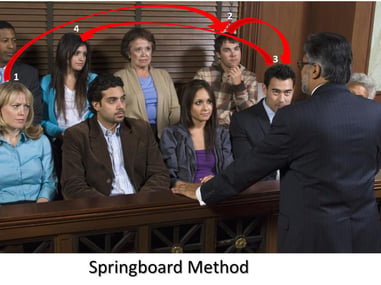
So far, our Tips series has focused on setting the stage for effective voir dire (Tip 1; Tip 2; and Tip 3), capitalizing on open-ended questions to increase our understanding of jurors (Tip 4), avoiding the “looking good” bias (Tip 5), crafting questions with the “bad” answer in mind (Tip 6), using questions that contrast viewpoints or positions (Tip 7), and the need to intersperse majority response questions to foster continued participation (Tip 8). Our next tip addresses the springboard method of questioning that enhances juror participation during voir dire. (Click here to see a short video for this tip.)
Fostering Participation
As I have stressed throughout this series, we need to employ approaches and methods that maximize juror participation and candor during the voir dire process. We started questioning by employing the initial background summary in Tip 2 and employed the initial hand-raising technique in Tip 3 to encourage participation at the beginning of voir dire. Our focus on participation shifted in Tip 8 to the inclusion of majority response questions to counteract nonparticipation tendencies inherent in traditional voir dire questioning. There is a potentially more effective method to maintain and increase participation—the springboard method.
Read More
Topics:
jury research,
group voir dire,
jury selection,
Jeffrey T. Frederick,
voir dire,
trial consultant,
questioning jurors,
juror candor,
looking good bias,
juror,
jury,
improving voir dire,
mastering voir dire,
juries,
majority response questions,
mastering group voir dire
November 21, 2018
Jeffrey T. Frederick, Ph.D.
Dr. Frederick’s ABA Books on Jury Selection Part of 40% Off Cyber Monday Sale

Cyber Monday Sale – 40% Off + Free Shipping
Shop and save one day only with promo code CYBER18 on books, eBooks, and on-demand CLE products.
Cyber Monday - November 26
Available at: https://www.americanbar.org/products/publishing/cybermonday2018/
If you need any assistance purchasing a product, please call the Service Center at (800) 285-2221.
ALSO, DON’T FORGET: Dr. Frederick will be presenting a free 60-minute program based on his book, “Mastering Voir Dire and Jury Selection: Gain an Edge in Questioning and Selecting Your Jury,” for the ABA Solo Small Firm and General Practice Division’s November 21, 2018, session of Hot Off the Press telephone conference/podcast at 1 p.m. EST. There is no registration or fee required. All you have to do is call the Dial-In Number and use the Conference ID listed below.
Read More
Topics:
jury research,
group voir dire,
jury selection,
Jeffrey T. Frederick,
voir dire,
trial consultant,
questioning jurors,
juror candor,
looking good bias,
juror,
jury,
improving voir dire,
mastering voir dire,
juries,
majority response questions,
mastering group voir dire
“I read your '8 Tips for Group Voir Dire' and thought it was one the best trial technique articles I have read. I really enjoyed it and will use the ideas in teaching my law school class.” - Roy Black, Esquire Black, Srebnick, Kornspan & Stumpf, P.A.
November 14, 2018
Jeffrey T. Frederick, Ph.D.
Mastering Group Voir Dire: Tip 8—Intersperse Majority Response Questions
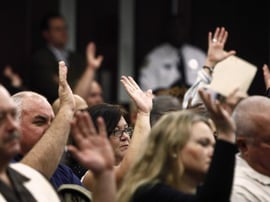 Associated Press 2012
Associated Press 2012
So far, our Tips series has focused on setting the stage for effective voir dire (Tip 1; Tip 2; and Tip 3), capitalizing on open-ended questions to increase our understanding of jurors (Tip 4), avoiding the “looking good” bias (Tip 5), crafting questions with the “bad” answer in mind (Tip 6), and using questions that contrast viewpoints or positions (Tip 7). Our next tip addresses asking questions later in voir dire where the majority of jurors will raise their hands. (Click here to see a short video for this tip.)
The Declining Participation Trap
A major problem often encountered during group voir dire is the tendency for participation by jurors to decline as questioning continues. This decline in participation is a result of two major forces. First, the way voir dire is conducted and the type of questions often asked tend to seek minority responses. That is, we are interested in nontypical information, and, as a result, only a few, if any, jurors respond affirmatively to these questions. Consider the following:
“How many of you have had a negative experience with law enforcement?”
“How many of you have been a party to a lawsuit?”
These types of questions focus on a likely minority of jurors who have had certain experiences or hold certain beliefs. This situation is further exacerbated by phrases that unnecessarily promote expectations of nonparticipation (and, potentially, negative connotations). Such phrasing is illustrated in the following approaches:
Read More
Topics:
jury research,
group voir dire,
jury selection,
Jeffrey T. Frederick,
voir dire,
trial consultant,
questioning jurors,
juror candor,
looking good bias,
juror,
jury,
improving voir dire,
mastering voir dire,
juries,
majority response questions,
mastering group voir dire
October 29, 2018
Jeffrey T. Frederick, Ph.D.
News: NLRG Voted Best Jury/Trial Consulting Service in Virginia, and Dr. Frederick’s Two Books are ABA “Best Sellers”
Two recent events highlight our Jury Research Services Division’s work and dedication to forwarding an understanding of jury behavior and jury trials for the legal community. These events are the number one ranking by Virginia Lawyers Weekly Readers for Best Jury/Trial Consulting Service and our two books on jury selection that currently are ABA best sellers. These books are showcased in the ABA newest and best-selling books in the Litigation category (2 of the 10 litigation books featured) with a corresponding 25% discount until October 31st.
Read More
Topics:
jury research,
group voir dire,
jury selection,
social media,
Jeffrey T. Frederick,
voir dire,
trial consultant,
questioning jurors,
jury honesty,
nonverbal communication,
social media and jurors,
Internet research,
agenda jurors,
common problems in jury selection,
juror misconduct,
challenges for cause,
how to ask questions for jurors,
peremptory challenges,
individual voir dire,
juror,
jury
May 8, 2018
Jeffrey T. Frederick, Ph.D.
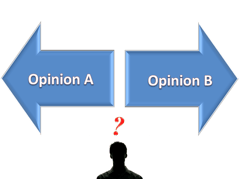
So far, our Tips series has focused on setting the stage for effective voir dire (Tip 1; Tip 2; and Tip 3), capitalizing on open-ended questions to increase our understanding of jurors (Tip 4), avoiding the “looking good” bias (Tip 5), and crafting questions with the “bad” answer in mind (Tip 6). Our next tip addresses asking questions that contrast important positions within the same question. (Click here to see a short video for this tip.)
Contrasting Viewpoints or Positions
The primary goal of voir dire and jury selection is to identify potential jurors who have a favorable or unfavorable initial orientation toward your case, ideally based on their beliefs, opinions, and values. Often the questions asked of jurors in pursuing this goal address a single value, position, or viewpoint. For example, “How many of you believe that the most important goal of sentencing in our criminal justice system is to punish those convicted of violent crimes?” Addressing a single position or viewpoint in one question has value, but this is not the only way to uncover critical opinions held by jurors. An alternate method is to contrast potentially opposing positions or viewpoints in the preface to the question and then ask jurors to choose which position is closer to their own. Consider the following examples.
“There are several viewpoints on the importance of various goals in our criminal justice system for the sentencing of those convicted of violent crimes. One view is that the most important goal is to punish those who commit violent crimes. A second view is that the most important goal is to rehabilitate those who commit such crimes. (It is possible to add other goals here.) Which of these viewpoints is closer to your view?”
Read More
Topics:
jury research,
group voir dire,
jury selection,
Jeffrey T. Frederick,
voir dire,
trial consultant,
questioning jurors,
looking good bias
February 27, 2018
Jeffrey T. Frederick, Ph.D.
ABA Publishing Announces the Release of Two Books on Jury Selection by Jeffrey T. Frederick, Ph.D.
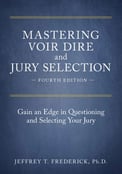
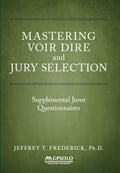
The American Bar Association’s Solo, Small Firm and General Practice Division announces the publication of two books on jury selection by one of the nation’s most experienced trial consultants. Since Mastering Voir Dire and Jury Selection: Gain an Edge in Questioning and Selecting Your Jury first appeared in 1995, its content has continually evolved, responding to changes in the law, social science research, and developments in jury trials. Its newly revised Fourth Edition includes an extensive discussion of the opportunities and challenges presented by the prevalence of the Internet and social media in jurors’ lives, and the applications of civilian voir dire and jury selection techniques to military courts-martial. The second book, Mastering Voir Dire and Jury Selection: Supplemental Juror Questionnaires, serves as a companion to the Fourth Edition. The book examines how to develop and use supplemental juror questionnaires and provides supplemental questionnaires used in more than 20 significant criminal and civil trials across the nation.
Mastering Voir Dire and Jury Selection: Gain an Edge in Questioning and Selecting Your Jury, Fourth Edition
This much anticipated and expanded fourth edition goes beyond other books on jury selection and focuses on the skills needed to conduct effective voir dire and jury selection, ultimately improving your chances of a favorable verdict at trial. This valuable guide will help you understand effective voir dire and jury selection strategies and adapt them to the unique circumstances you face in your trial jurisdiction.
Read More
Topics:
jury research,
group voir dire,
jury selection,
social media,
juror questionnaires,
Jeffrey T. Frederick,
voir dire,
trial consultant,
questioning jurors,
jury honesty,
nonverbal communication,
social media and jurors,
Internet research,
agenda jurors,
common problems in jury selection,
juror misconduct,
challenges for cause,
how to ask questions for jurors,
peremptory challenges,
Batson,
individual voir dire
February 8, 2018
Jeffrey T. Frederick, Ph.D.

So far, our Tips series has focused on setting the stage for effective voir dire (Tip 1; Tip 2; and Tip 3), capitalizing on open-ended questions to increase our understanding of jurors (Tip 4), and avoiding the “looking good” bias (Tip 5). Our next tip addresses potential “bad” answers and how to use them to ask better questions and get better overall results. (Click here to see a short video for this tip.)
Bad Answers
Our goal in jury selection is to identify potentially unfavorable jurors whom we need to remove either through challenges for cause or peremptory challenges. The unfavorability of jurors is primarily based on their having opinions and values that would lead them to view your client’s case negatively or, conversely, to view your opponent’s case positively. While jurors certainly may have had relevant negative experiences or work experiences in areas unfavorable to a client, our attention here is on the jurors’ unfavorable opinions and values themselves. That is, we look for the unfavorable opinions and values, what we term “bad” answers, as reflected in what jurors tell us during voir dire (or on supplemental juror questionnaires). The following are a few of the topic areas where “bad” answers are likely found:
Read More
Topics:
jury research,
group voir dire,
jury selection,
Jeffrey T. Frederick,
voir dire,
trial consultant,
questioning jurors,
jury honesty,
looking good bias
June 7, 2017
Jeffrey T. Frederick, Ph.D.
The initial tips in our Tips series have focused on setting the stage for effective voir dire (Tip 1; Tip 2; and Tip 3) and capitalizing on open-ended questions (Tip 4) to increase our understanding of jurors. Now I turn to a major problem in jury selection, the looking good bias, and how to avoid evoking it in jurors. (Click here to see a short video for this tip.)
Looking Good Bias
The “looking good” bias (i.e., the socially desirable response bias) is an impression management strategy designed to portray a positive image of oneself to others. This bias promotes responses that are not true reflections of the individual’s beliefs or experiences, but reflect a desire by the individual to have others think positively of him or her. In the case of jurors, this looking good bias fosters answers that reflect what jurors think the lawyer wants to hear or what they think are socially acceptable answers designed to create a positive impression of themselves. Obviously, this is exactly what we don’t want jurors to do. The looking good bias is fundamentally different from biases that can arise out of (a) exposure to case information whose influence is unrecognized by jurors or (b) implicit bias that reflects a general bias against a party.
Read More
Topics:
jury research,
group voir dire,
jury selection,
Jeffrey T. Frederick,
voir dire,
trial consultant,
questioning jurors,
jury honesty,
looking good bias
May 16, 2017
Jeffrey T. Frederick, Ph.D.

So far in the Tips series, the focus has been on setting the stage for effective voir dire by (a) treating voir dire as a conversation with jurors (Tip 1); (b) using techniques that help jurors feel comfortable with speaking in court (Tip 2); and capitalizing on the initial hand-raising technique to encourage participation in the voir dire process (Tip 3). I turn now to the nature of the questions themselves, in particular open-ended versus closed-ended questions. While both of these formats have their place in a well-conducted voir dire, one format, open-ended questions, deserves special attention. Knowing how and when to use open-ended questions can vastly improve your effectiveness in jury selection. (Click here to see a short video for this tip.)
Open-Ended v. Close-Ended Questions
A major distinction in the phrasing of questions is whether the question is phrased in an open-ended versus closed-ended format. Open-ended questions are those questions that do not provide the answer within the question itself. These questions are often prefaced with phrases such as, “What do you think/feel/believe about . . .”; “Why?”; “In what way . . .”. These questions focus jurors’ attention on the topic, yet leave it to them to formulate an answer. The following are examples of the open-ended approach:
“How do you feel about patients bringing lawsuits against doctors over the treatment they received?”
“What would your impression be of defendants in criminal trials who do not testify in their own defense?”
“What is your opinion of the law that allows for money damages designed to punish a defendant?”
Read More
Topics:
jury research,
jury selection,
Jeffrey T. Frederick,
voir dire,
voir dire setting,
trial consultant,
getting jurors to talk,
questioning jurors,
juror candor,
juror honesty






 Associated Press 2012
Associated Press 2012






